Estimated reading time: 13 minutes
Keeping up with your feline friend’s feeding schedule can be an uphill task, particularly if you lead a busy lifestyle. In fact, automatic cat feeders are becoming increasingly popular as they use innovative technologies to ensure that your cats get their meals on time and in the right portion sizes.
This article will guide you through the workings of these smart devices, from automated feeding systems to advanced portion control mechanisms. Can’t wait? Then hang tight as we dive into this intriguing topic together!
Key Takeaways
- Automatic feeders for cats use innovative technologies to ensure that cats get their meals on time and in the right portion sizes.
- They work by using an automated feeding system to dispense food at specific times, a refilling mechanism to keep the feeder stocked with food, and portion control settings to ensure the right amount of food is given.
- There are three main types of automatic cat feeders: gravity-based feeders, programmable timed feeders, and microchip-controlled feeders.
- Important considerations when using an automatic cat feeder include choosing the right feeder for your cat’s needs, monitoring and adjusting portion sizes, ensuring regular maintenance and cleaning, and consulting with a veterinarian for guidance.
Pros and Cons of Automatic Cat Feeders
Automatic cat feeders have both advantages and disadvantages. They provide regular feeding times and easy access to food, keeping it fresher for longer. However, they may malfunction when cats are alone and can also encourage overeating.
Regular Feeding Times
Automatic cat feeders help set regular feeding times for your cat. This way, you can feed your cat at the same time every day. It helps keep their tummy happy and their body healthy. It does not matter if you are home or away. The feeder will give out food at the right time always!
Easy Access to Food
With an automatic cat feeder available, your pet will always find the food ready. As a cat parent, you can keep peace of mind knowing no matter how late or busy you are, the feeder does its job. These feeders ensure that your kitty never goes hungry.
The feeder dispenses just enough food for one meal at set times each day. Your feline friend doesn’t have to wait for you to get home from work. An automatic pet feeder truly gives cats easy access to food all day long.
Keeps Food Fresher for Longer
An automatic cat feeder keeps your pet’s food fresh for a longer time. It is better than a regular bowl where food can get stale fast. Some feeders offer special features, like ice packs.
These are perfect for wet or dry food to stay good longer. This way, every meal is as tasty and fresh as can be. The fresher the food, the happier your feline friend will be!
May Malfunction When Cats Are Alone
Automatic cat feeders can sometimes have issues when cats are left alone. These feeders may malfunction, leading to overfeeding or underfeeding. It’s important for pet owners to be aware of this possibility and monitor their cat’s feeding habits closely.
Curious cats may also try to tip over the feeder in order to access the food inside. In addition, some cats may experience separation anxiety when left alone without human presence, which can affect their appetite and eating routine. The automatic feeder is not a replacement for a reliable pet sitter.
Therefore, it is essential for cat owners to choose a reliable automatic feeder and consider alternative feeding options if necessary.
May Encourage Overeating
Automatic cat feeders may unintentionally encourage overeating in cats. This can happen because some cats have an instinct to eat whenever food is available, even if they’re not hungry.
With automatic feeders, the food is always accessible, which means your cat could end up eating more than necessary. This can lead to weight gain and other health issues for your furry friend.
It’s important to monitor your cat’s portion sizes and adjust them accordingly to prevent overeating when using an automatic feeder.
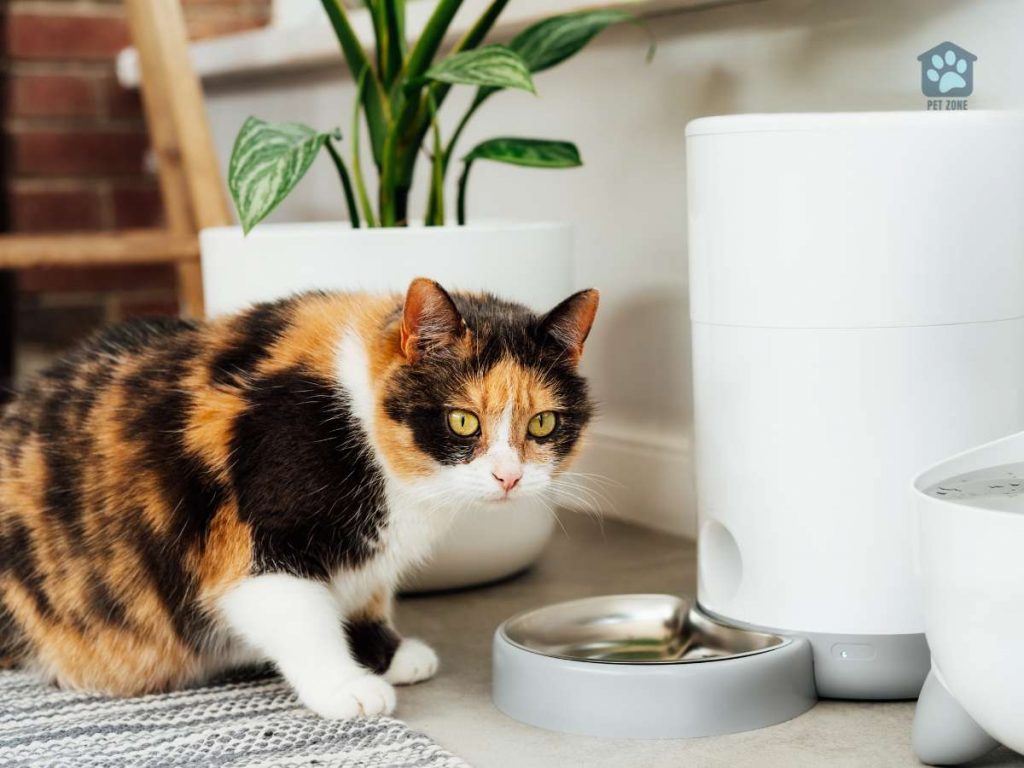
How Automatic Cat Feeders Work
Automatic cat feeders work by using an automated feeding system to dispense food at specific times, a refilling mechanism to keep the feeder stocked with food, and portion control settings to ensure the right amount of food is given to the cat.
Automated Feeding System
An automated feeding system is the heart of an automatic cat feeder. It’s responsible for dispensing the right amount of food to your furry friend. These systems can be programmed to provide food at specific times and in specific quantities, ensuring that your cat gets regular meals even when you’re not home.
Some feeders use a conveyor belt-powered mechanism to slow down fast eaters, while others can handle different kibble shapes and sizes. With an automated feeding system, you can have peace of mind knowing that your pet will be fed even when you’re away.
Refilling Mechanism
Automatic cat feeders have a refilling mechanism that replenishes the food bowl as the cat eats. This ensures that there is always enough food available for your furry friend. The refill process is triggered when the cat creates space in the bowl by consuming the food.
For gravity-based feeders, this means that the storage container above will automatically release more food when there is space for it to drop down into the bowl. This simple yet effective mechanism ensures that your cat always has access to fresh food and you can have peace of mind knowing that they are being fed regularly.
Portion Control
One important feature of automatic cat feeders is portion control. These feeders are designed to dispense a predetermined amount of food at set times, ensuring that your pet receives the correct amount every day.
You can program the feeder to provide multiple small meals throughout the day, promoting portion control and preventing overeating or underfeeding. Portion control saves time by eliminating the need for manual measurement of meals and helps maintain your pet’s health by preventing them from eating too much or too little.
With an automatic cat feeder, you can have peace of mind knowing that your furry friend is getting just the right amount of food they need.
Types of Automatic Cat Feeders
There are three main types of automatic cat feeders: gravity-based feeders, programmable timed feeders, and microchip-controlled feeders.
Gravity-based Feeders
Gravity-based feeders are a simple and low-tech option for automatic cat feeding. They work by using the force of gravity to dispense food into the bowl as your cat eats. These feeders don’t require electricity or batteries to function, which makes them convenient and easy to use.
As your cat consumes the food in the bowl, more food automatically refills from the storage compartment above. However, it’s important to note that gravity-based feeders don’t have timers or portion control features, so they may not be suitable for cats that tend to overeat or for owners who want precise control over their pet’s meals.
Programmable Timed Feeders
Programmable timed feeders are a type of automatic cat feeder that allows you to set specific feeding times for your furry friend. These feeders have programmable features that let you control when and how much food is dispensed to your cat.
They are great for pet owners who want to ensure their cats are fed on a regular schedule, even when they’re not home. The PetSafe Smart Feed 2.0 Automatic Pet Feeder and the PETLIBRO Automatic Pet Feeder are popular choices because of their versatility in programming options.
With these feeders, you can easily customize your cat’s feeding schedule based on their needs and keep them well-fed even when you’re not around.
Microchip-Controlled Feeders
Microchip-controlled feeders are a type of automatic cat feeder that uses your cat’s microchip or a lightweight RFID collar tag to regulate their food schedule. These feeders work by recognizing the unique ID on the microchip and opening the lid to allow your cat access to their food.
One example of a microchip-controlled feeder is the SureFeed Microchip Cat Feeder, which remains closed when not being accessed by your cat. This type of feeder provides convenience and ensures that each pet receives the right amount of food without any stealing from other pets.
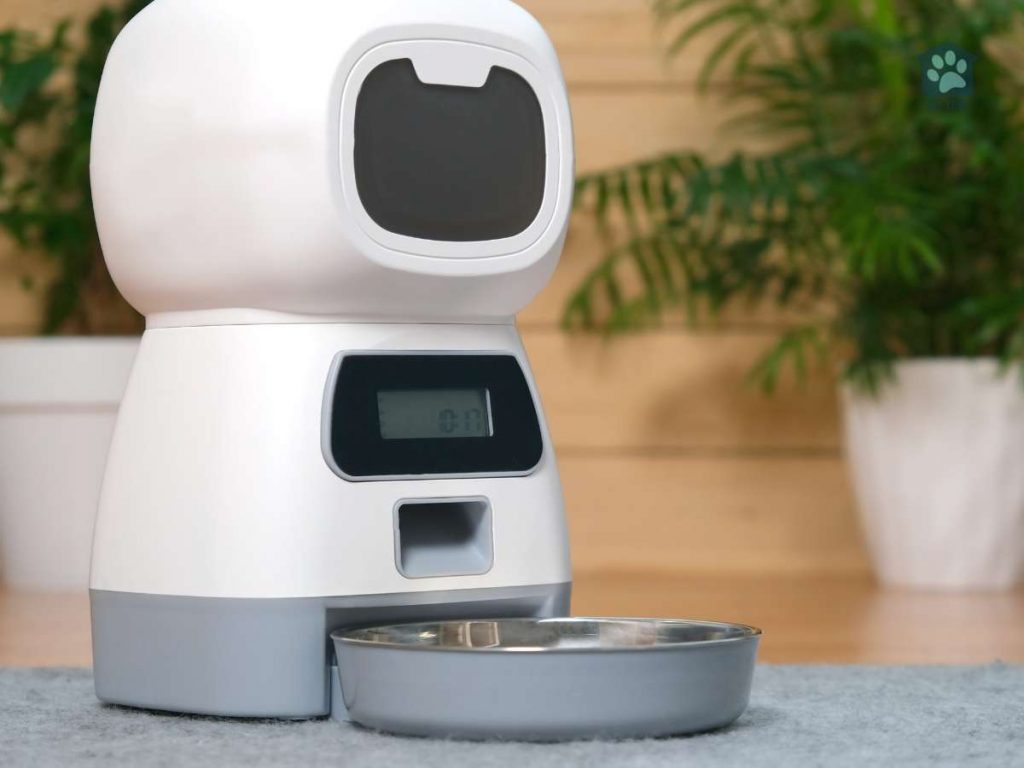
Considerations When Using an Automatic Cat Feeder
Choosing the right feeder for your cat’s needs. Monitor and adjust portion sizes regularly. Ensure regular maintenance and cleaning. Pay attention to your cat’s health and behavior.
Consult with a veterinarian for advice and guidance. Explore these important considerations when using an automatic cat feeder!
Choosing the Right Feeder for Your Cat’s Needs
To ensure your cat’s needs are met with an automatic feeder, here are some important factors to consider:
- Food Type: Determine if the feeder can handle both dry and wet food, as some feeders may only accommodate one type.
- Feeder Capacity: Consider the amount of food the feeder can hold to ensure it is suitable for your cat’s feeding requirements.
- Portion Control: Look for a feeder that offers portion control settings, allowing you to regulate the amount of food dispensed at each feeding.
- Feeding Schedule: Check if the feeder has customizable feeding schedules, allowing you to set specific times for each meal.
- Additional Features: Consider any extra features that may be beneficial, such as timers, LCD screens for easy programming, or compatibility with ice packs to keep wet food fresh.
Monitoring and Adjusting Portion Sizes
Monitoring and adjusting portion sizes is an important aspect of using an automatic cat feeder. Here are some tips for pet lovers:
- Check the recommended daily intake: Consult with your veterinarian to determine the appropriate amount of food your cat should be consuming each day. This will vary based on factors such as age, weight, and activity level.
- Start with the baseline setting: Most automatic feeders come with preset portion sizes. Begin by selecting a portion size that aligns with your veterinarian’s recommendation.
- Observe your cat’s eating habits: Monitor how much food your cat consumes during each feeding. If they consistently leave food behind or finish it too quickly, you may need to adjust the portion size.
- Gradually increase or decrease portions: If you notice that your cat is gaining or losing weight, make gradual adjustments to the portion size as recommended by your veterinarian. This will help maintain a healthy weight.
- Use the feeder’s features: Some automatic feeders allow you to customize portion sizes according to specific meal times. Take advantage of these features to ensure that your cat receives appropriate amounts of food throughout the day.
Ensuring Regular Maintenance and Cleaning
Regular maintenance and cleaning are important for keeping your automatic cat feeder hygienic and in good working condition. Here are some steps to follow:
- Follow the manufacturer’s instructions: Read the user manual provided with your automatic cat feeder to understand how to properly clean and maintain it.
- Clean the food bowl: Remove the food bowl from the feeder and wash it with warm, soapy water. Rinse it thoroughly to remove any soap residue, as it could be harmful to your cat.
- Wipe down the feeder: Use a damp cloth or sponge to wipe down the exterior of the automatic cat feeder, removing any dust or debris that may have accumulated.
- Check for food buildup: Take a look inside the feeding mechanism to ensure there is no leftover food stuck or clogged. If you notice any blockages, carefully clean them out using a soft brush or toothpick.
- Replace filters as needed: Some automatic cat feeders come with filters that help keep the food fresh. Follow the manufacturer’s guidelines on when and how to replace these filters.
- Inspect for wear and tear: Regularly check for any signs of damage or wear on your automatic cat feeder, such as cracks or loose parts. If you notice any issues, contact the manufacturer for assistance.
- Refill with fresh food: After cleaning your automatic cat feeder, refill it with fresh, high-quality cat food according to your pet’s dietary needs.
Monitoring Your Cat’s Health and Behavior
Monitoring your cat’s health and behavior is important for their overall well-being. Here are some key things to keep an eye on:
- Eating habits: Pay attention to how much food your cat is consuming. Sudden changes in appetite could indicate a health issue.
- Water intake: Make sure your cat is drinking enough water. Dehydration can lead to serious health problems.
- Weight: Regularly check your cat’s weight to ensure they maintain a healthy body condition. Obesity or sudden weight loss can be concerning.
- Litter box habits: Monitor your cat’s litter box usage to ensure they are urinating and defecating regularly. Changes in frequency or consistency may signal an underlying problem.
- Energy levels: Notice any changes in your cat’s activity levels or behavior patterns. Unexplained lethargy or excessive restlessness could be indicators of illness.
- Coat condition: Keep an eye on the quality of your cat’s fur. Dullness, excessive shedding, or skin issues may require veterinary attention.
- Vomiting or diarrhea: Occasional episodes may not be concerning, but frequent or persistent vomiting and diarrhea should be evaluated by a veterinarian.
- Dental health: Look out for bad breath, swollen gums, tartar buildup, or reluctance to eat hard food, as these may indicate dental issues.
- Behavioral changes: Pay attention to any unusual behaviors such as aggression, excessive meowing, hiding, or withdrawal from social interaction.
- Regular vet visits: Schedule routine check-ups with your veterinarian to assess overall health and address any concerns promptly.
Consulting with a Veterinarian for Advice and Guidance
It is important to consult with a veterinarian when using an automatic cat feeder. They can provide valuable advice and guidance based on your cat’s specific needs and health conditions.
A veterinarian can help you choose the right feeder, monitor portion sizes, and ensure that the feeder is properly maintained and cleaned. They can also address any concerns or questions you may have about using an automatic cat feeder.
Consulting with a veterinarian is especially crucial if your cat has dietary restrictions or medical issues. Their expertise will ensure that your cat’s nutritional needs are met while using an automatic feeder.
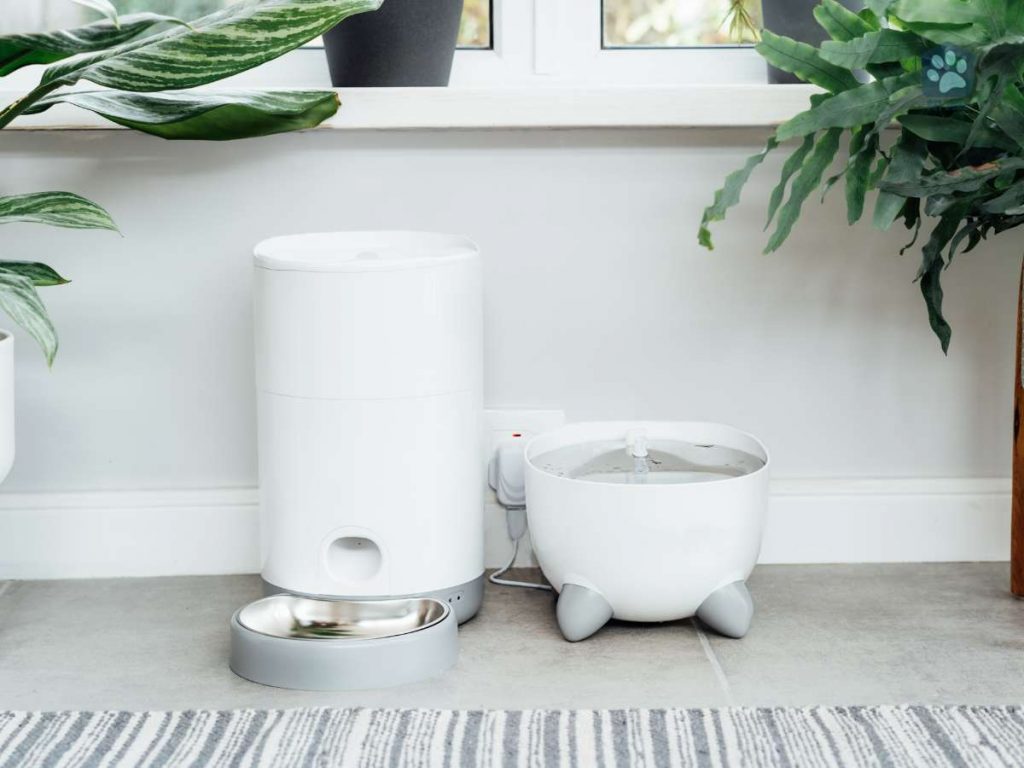
Conclusion
Automatic cat feeders work by using an automated system to dispense food at specific times and in predetermined portions. They can be a convenient solution for pet owners who have busy schedules or are away from home for long periods.
However, it is important to carefully consider the pros and cons of using automatic feeders and ensure that they meet your cat’s individual needs.
Frequently Asked Questions
An automatic cat feeder is a dispenser or machine that gives dry food or wet food to your pet.
The best automatic feeders control the amount of food given to your cat. It can use RFID technology to tell one cat from another for owners with multiple cats.
No, there are many models of feeders. Some basic ones just drop a cup of food at set times. A smart feeder like Petlibro Automatic Feeder or Cat Mate C500 Digital can let you choose when and how much your pet gets fed.
Yes! If the size fits inside the machine, you can use it for both cats and dogs.
Some high-end feeders come with “food stealing” prevention features that keep the wrong pet from eating all the food.
Automatic Feeders are considered safe but it shouldn’t replace human care entirely as one also must ensure water availability and cleanliness around feeding area.
As an Amazon Associate I earn from qualifying purchases.
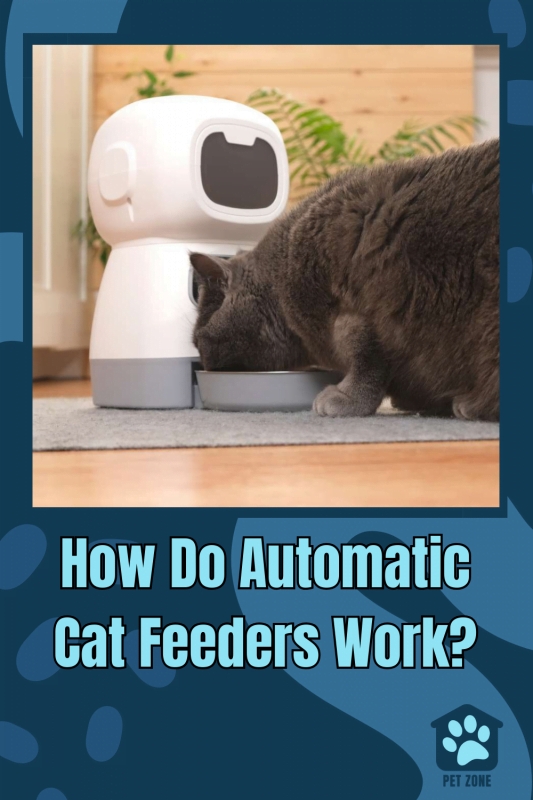


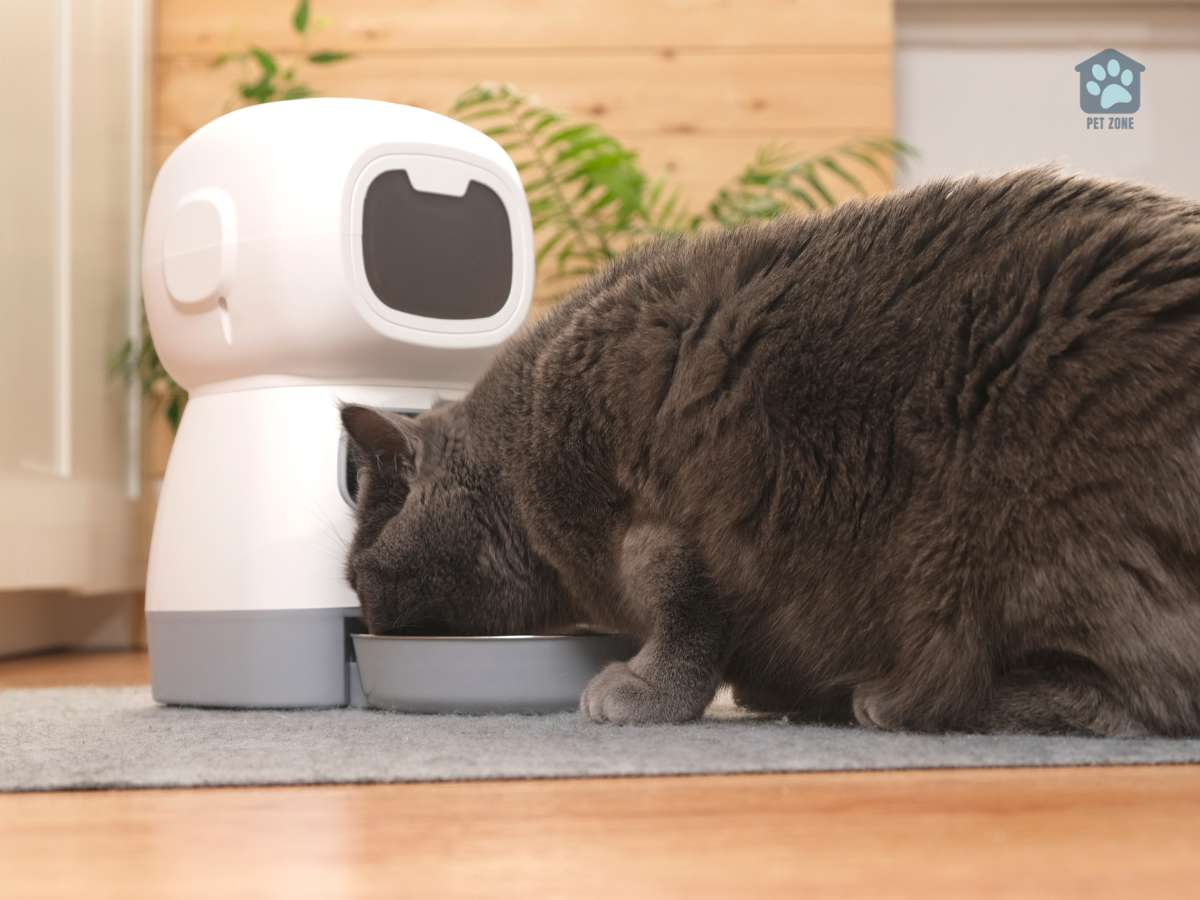
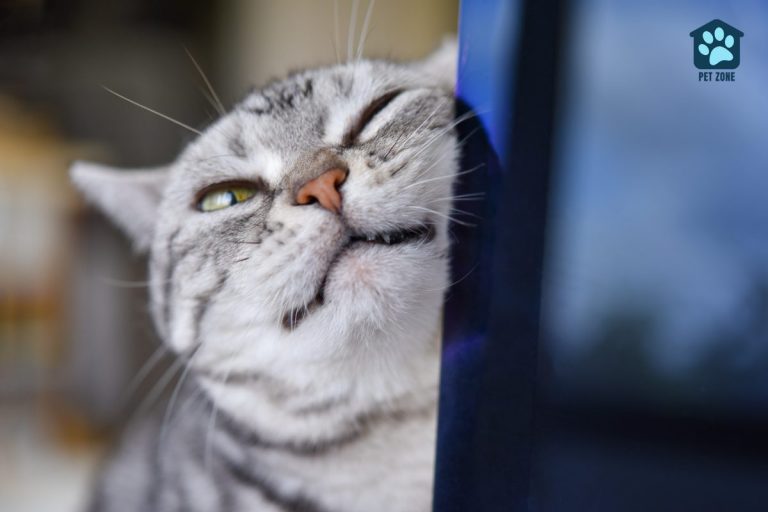
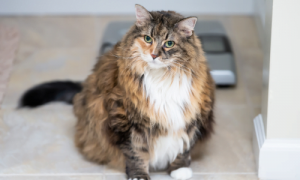
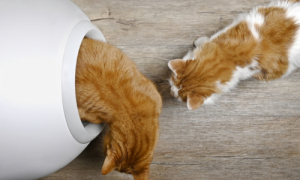
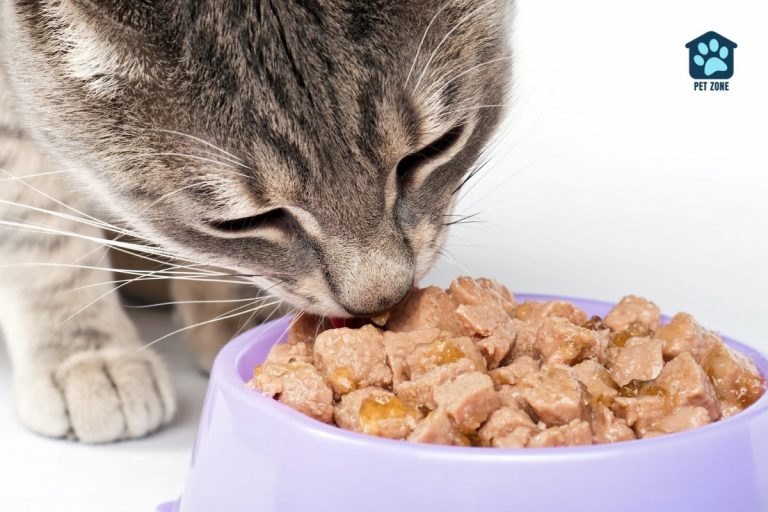
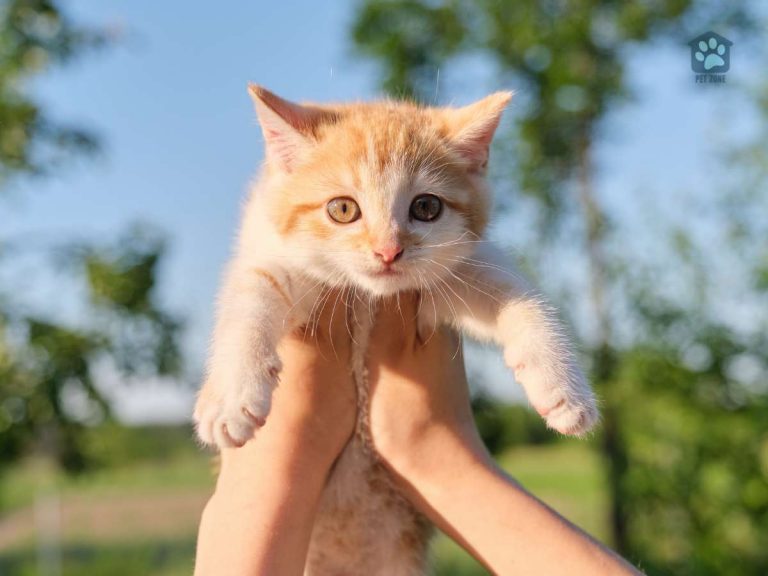
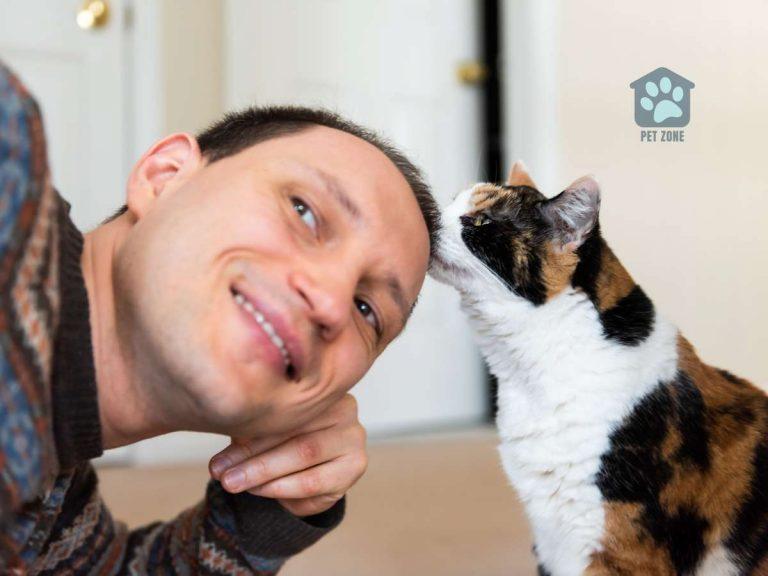
Great information! I think these would make my mornings less stressful and probably make it easier on my house sitter(s) when I travel. Bookmarking!
This is super helpful information! I got an automatic cat feeder for my parents’ cat and they and the cat love it! They used to overfeed her and the automatic feeder took the guesswork out of whether someone had already fed her. Plus the cat seems to like the predictability of the feeder and begs for food less. They’re definitely a cool resource if you account for the downsides you mention.
I bought an automatic feeder a few months back for when I am out of town and love it. Works like a charm.